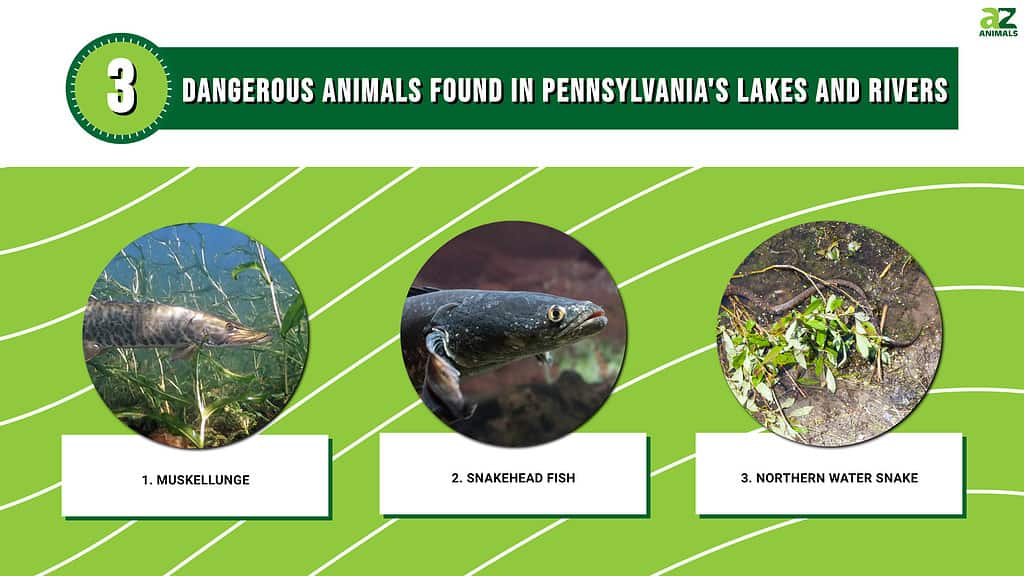Freshwater sources in Pennsylvania offer more than just hydration. They provide energy, transportation, irrigation, manufacturing, and recreation. Life happens around lakes and rivers. However, there are also dangerous animals found in Pennsylvania’s lakes and rivers.
It’s natural to be curious about what lives in the water we use for swimming, fishing, and boating. What creatures live in freshwater that could potentially be harmful to our families and pets? Beware of these three dangerous animals in Pennsylvania’s waterways. We’ll tell you where they reside and the problems they cause.

About Pennsylvania’s Lakes and Rivers

The Ohio River and the Susquehanna River are the longest in Pennsylvania, which has 86,000 rivers, streams, and creeks.
©Jayce Wyatt Photography/Shutterstock.com
Pennsylvania is one of the top states in the country for outdoor recreation. Within its borders are over 2,500 lakes and 86,000 rivers, streams, and creeks. The state is a paradise for fishing, boating, kayaking, and swimming. The largest lake in Pennsylvania is Lake Erie, the only Great Lake in the state. And the Ohio River and the Susquehanna River are the longest rivers in Pennsylvania.
This northeastern state boasts an impressive amount of water. But where there’s water, there is wildlife. And you should always take proper precautions. It is important to know what lives in a particular lake or river before diving in.
Dangerous Animals Found in Pennsylvania’s Lakes and Rivers
Despite its many bodies of water, Pennsylvania does not contain many dangerous freshwater species. Most animals you will encounter in the water are harmless. But it’s still a good idea to look out for these three.

The muskies’ native range is in the northeastern range of Pennsylvania and some western regions near New York.
©Engbretson, Eric / U.S. Fish and Wildlife Service, Public domain, via Wikimedia Commons – Original / License
The muskellunge, or muskie for short, is a large freshwater fish from the pike family. They are predatory fish that resemble the northern pike, featuring either no pattern, spots, or oblique stripes. Muskies have elongated bodies, flattened heads, and fins set far back. But their most notable features are their large mouths filled with strong canines and their significant size. Some of the biggest muskies grow up to 6 feet long and weigh nearly 70 pounds.
While muskies do not regularly attack humans, there have been instances where people have become injured. They have been known to bite limbs, shake, and even pull people underwater. Some people have required stitches after dealing with an aggressive muskellunge. However, this is rare.
You can find muskies in many lakes and rivers in the state, including Lake Erie and the Ohio River watersheds. Their native range is in the northeastern range of Pennsylvania and some western regions near New York.
Snakehead Fish

Snakeheads are known for being aggressive and will bite humans that get too close to their nest.
©bigjom jom/Shutterstock.com
Snakeheads are predatory freshwater fish native to Africa and Asia. They feature elongated bodies, long fins, large mouths, and sharp teeth. This species is unique in the fish world. It can breathe air with its gills and can move across the land for short distances. And they prey on other fish, amphibians, insects, and small mammals. Snakeheads are considered an invasive species because they disrupt the ecosystem.
These fish are known for being aggressive and will bite humans that get too close to their nest. And due to their sharp teeth, they can cause damage to fingers and other body parts. However, most will avoid humans. This invasive species has been reported in Delaware, Chester, and Bucks counties. And they live in and around lakes, rivers, and ponds.
Northern Water Snake

While northern water snakes are solitary and non-venomous, they can become aggressive when you get too close.
©iStock.com/Kyle Reynolds
The northern water snake is a common sight in the eastern half of the country, especially in the Northeast. This species can feature varying shades, from gray, tan, or brown. They also feature dark bands and range in size between two and 4.5 feet long. These water snakes like areas around ponds and lakes where they can bask in the sun. You can also find them dangling on overhanging vegetation or nearby walkways.
While northern water snakes are solitary and non-venomous, they can become aggressive when you get too close. It is not rare for these snakes to swim toward swimmers and anglers, even biting if they are particularly agitated. These snakes live across Pennsylvania streams, rivers, lakes, and ponds.
Another notable snake you might spot close to water (not in) is the northern copperhead. This species is large and venomous, latching its long fangs into those who accidentally step on them.
The photo featured at the top of this post is © cwieders/Shutterstock.com
Thank you for reading! Have some feedback for us? Contact the AZ Animals editorial team.







